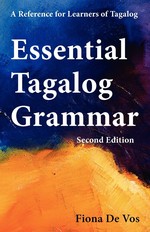Tagalog May, Mayroon/Meron, Marami, Wala’: Overview
May, mayroon/meron (meron in spoken Tagalog) and marami are used to indicate existence or possession. Wala’ indicates non-existence or non-possession.
|
May… Merong… |
There is/are/was/were (a/some)…. |
has/have/had (a/some)… |
|
Maraming… |
There are/were many…. There is/are/was/were a lot of…. |
has/have/had many… has/have/had a lot of… |
|
Walang… |
There is/are/was/were no…. |
has/have/had no… |
|
May… Merong… |
|
There is/are/was/were (a/some)…. |
|
has/have/had (a/some)… |
|
Maraming… |
|
There are/were many…. There is/are/was/were a lot of…. |
|
has/have/had many… has/have/had a lot of… |
|
Walang… |
|
There is/are/was/were no…. |
|
has/have/had no… |
Note: Meron, marami and wala’ are linked to the existing/non-existing or possessed/non-possessed object by -ng. See also: Na/-ng (p. 28)
Examples:
|
May aso. Merong aso. |
There is a dog. |
|
May mangga. Merong mangga. |
There is a mango. There are some mangoes. |
|
Maraming aso. |
There are many dogs. |
|
Maraming asukal. |
There’s a lot of sugar. |
|
Walang aso. |
There are no dogs. |
|
May aso si Alfred. Merong aso si Alfred. |
Alfred has a dog. |
|
May mangga si Alfred. Merong mangga si Alfred. |
Alfred has a mango. Alfred has some mangoes. |
|
Maraming aso si Alfred. |
Alfred has many dogs. |
|
Maraming pera si Alfred. |
Alfred has a lot of money. |
|
Walang aso si Alfred. |
Alfred has no dogs. Alfred doesn’t have a dog. |
Note:
|
May susi’ si Fred. |
Fred has a key. |
|
Na kay Fred ang susi’.* |
Fred has the key. Lit. The key is with Fred. |
* See also: Nasa (p. 255)
For other uses of wala’, see: Wala’ sa, wala’ rito (p. 259)
Please respect copyright. Learn more
Contents | Detailed Contents | Up ▲
See notes on Terminology and Pronunciation Marks
This grammar guide is part of the Learning Tagalog Course.
Do you want to speak Tagalog fluently?

From Essential Tagalog Grammar: A Reference for Learners of Tagalog, Second Edition
By Fiona De Vos
“I got a copy of your book and I love it. It’s really the best I’ve come across.”
— Martin Kelemenis, Geneva, Switzerland